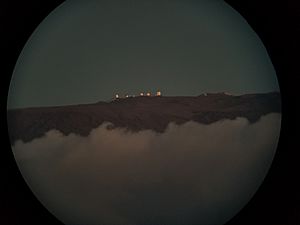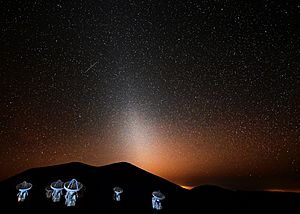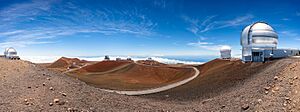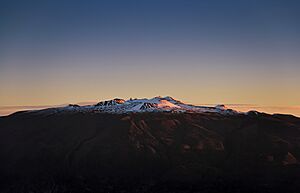Mauna Kea Observatories facts for kids
Quick facts for kids
|
|||||||||||||||||||||||||||
The Mauna Kea Observatories (MKO) are a group of powerful telescopes. They are located at the very top of Mauna Kea mountain. This mountain is on the Big Island of Hawaiʻi in the United States.
This area is special because it has very dark skies. There is not much light from cities. The air is also very clear and dry. Mauna Kea is 4,205 meters (13,796 feet) high. This puts the telescopes above most of the clouds and water vapor. These conditions make it one of the best places on Earth to study space.
Contents
How the Observatories Started
Even before the current observatories, people were interested in astronomy on Mauna Kea. An old map from 1901 shows a "Hawaii Astronomy Station" near the top.
Searching for a Perfect Spot
In the 1960s, a scientist named Gerard Kuiper was looking for a dry place. He wanted to study space using infrared light. He tested different places, including another Hawaiian mountain called Haleakalā. But Mauna Kea was even better.
Kuiper found that Mauna Kea's air was very dry. This was perfect for infrared studies. He convinced the Governor of Hawaiʻi to build a dirt road to the summit. There, he set up a small telescope. He chose a peak that was not the very highest, as the highest peak was considered sacred.
Building the First Telescope
Later, the University of Hawaii joined the effort. Professor John Jefferies led their team. They won a contract to build a larger telescope. This made Kuiper upset, as he felt it was "his mountain."
After more tests, they found the best spots for telescopes were near the top of the cinder cones. They also confirmed Mauna Kea was excellent for night viewing. This was due to the thin air, steady winds, and being surrounded by the ocean. Building started in 1967, and the first telescope saw "first light" in 1970.
Growing the Observatory Site
Soon, other groups wanted to build telescopes on Mauna Kea too. By 1970, two smaller telescopes were built. In 1973, Canada and France decided to build the 3.6-meter CFHT.
Over time, more telescopes were added. Today, the Mauna Kea Science Reserve has 13 observation facilities. Many countries help fund these telescopes. It is one of the world's top observatories for different types of astronomy.
Amazing Discoveries from Mauna Kea
The telescopes on Mauna Kea have helped scientists make big discoveries.
Finding a Super-Planet
In November 2020, scientists used the Gemini observatory and the NASA Infrared Telescope Facility (NITF) on Mauna Kea. Working with another telescope in Europe, they found the first "Super-Planet." This is a very large planet.
Discovering Dark Energy
In 2011, three scientists won the Nobel Prize in Physics. Their names were Saul Perlmutter, Brian P. Schmidt, and Adam G. Riess. Their research, done partly at Mauna Kea, showed something amazing. They found that the universe is expanding faster and faster. This is caused by a mysterious force called dark energy.
Managing the Observatories
The land where the observatories sit is leased by the State of Hawaiʻi. The University of Hawaiʻi manages the site. They lease land to different groups from many countries. These groups have invested a lot of money in science and technology.
There are ongoing discussions about how the mountain should be managed. Some local people feel that too many telescopes have been built. They want to have more say in how the land is used. New plans are being made to include the local community in managing the mountain. This will ensure that the cultural and environmental importance of Mauna Kea is respected.
Why Mauna Kea is Special

Mauna Kea is a great place for astronomy because of its high altitude. It is also far away from city lights, right in the middle of the Pacific Ocean. This makes it one of the best spots on Earth for telescopes that look at visible light, infrared light, and submillimeter waves.
Visitor Information
There is a visitor information station at 9,200 feet (2,800 meters) above sea level. Tourists are told to stop here for at least 30 minutes. This helps them get used to the thinner air before going higher. Scientists often stay at a place called Hale Pōhaku, which is at 9,300 feet (2,835 meters). They stay there for several hours or even a full night before working at the telescopes on the summit. This helps them avoid altitude sickness.
Telescopes at Mauna Kea
Many different countries and organizations fund the telescopes on Mauna Kea. The University of Hawaiʻi directly manages two of them. In total, there are 12 facilities with 13 telescopes at or near the summit.
Here are some of the telescopes:
- Caltech Submillimeter Observatory (CSO): This telescope closed in 2015.
- Canada–France–Hawaiʻi Telescope (CFHT): Funded by Canada, France, and the University of Hawaiʻi.
- Gemini North Telescope: Supported by the United States, United Kingdom, Canada, Chile, Australia, Argentina, and Brazil.
- NASA Infrared Telescope Facility (IRTF): Operated by NASA.
- James Clerk Maxwell Telescope (JCMT): Funded by China, Japan, South Korea, Taiwan, the United Kingdom, and Canada.
- Subaru Telescope: From the National Astronomical Observatory of Japan.
- Sub-Millimeter Array (SMA): Supported by Taiwan and the United States.
- United Kingdom Infrared Telescope (UKIRT): Supported by Lockheed Martin, the University of Hawaiʻi, and the University of Arizona.
- University of Hawaiʻi 88-inch telescope (UH88): Run by the University of Hawaiʻi.
- University of Hawaiʻi 36-inch telescope (Hoku Kea): Operated by the University of Hawaii at Hilo.
- One receiver of the Very Long Baseline Array (VLBA): From the United States.
- W. M. Keck Observatory: Managed by the California Association for Research in Astronomy.
Some of these telescopes, like CSO, UKIRT, and Hoku Kea, are planned to be taken out of service.
Concerns and Protests
Building telescopes on Mauna Kea has led to some disagreements. Many Native Hawaiians (kānaka ʻōiwi) believe the entire mountain is sacred. They feel that building on it, even for science, harms the area. Environmental groups are also worried about rare native birds and other wildlife.
Why People Are Concerned
- Cultural Importance: For Native Hawaiians, Mauna Kea is a very important spiritual and cultural place. They see it as a home to gods and ancestors.
- Environmental Impact: Groups like the Hawaiian Audubon Society are concerned about the Palila bird. This endangered bird lives only on Mauna Kea. They worry that building more telescopes could harm its habitat.
- Visual Impact: Some people in the nearby city of Hilo are concerned about how the telescope domes look from the city.
These concerns have led to a "Save Mauna Kea" movement. People want to protect the mountain's natural and cultural value. The land is protected by a US law because of its importance to Hawaiian culture. However, development has still been allowed.
2006 Kiholo Bay Earthquake
On October 15, 2006, an earthquake hit Kiholo Bay. Some of the telescopes on Mauna Kea had minor damage. But most of them, like the CFHT and W. M. Keck Observatory, were back up and running within a few days.
Images for kids
See also
 In Spanish: Observatorios de Mauna Kea para niños
In Spanish: Observatorios de Mauna Kea para niños
- Timeline of telescopes, observatories, and observing technology
- List of largest optical reflecting telescopes
- Hubble Space Telescope







